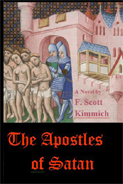
 |
We hear almost daily from the news media about atrocities committed by the Islamic State and Boko Haram as they terrorize those whose religious beliefs differ from theirs. Yet, wars over the way one views and follows God are hardly limited to modern times. Some of the bloodiest massacres took place in the medieval period during the various crusades ordered by the Roman Catholic Church against those it viewed as infidels or heretics. Although countless pages have been dedicated to recounting the crusades to the Middle East, few have focused on the ones centered in Europe. Kimmich's gripping historical novel of the Albigensian Crusade in the south of France seeks to rectify that.
The author's chief protagonist is Olivier de Mazan, a man who, like many of the residents of le Midi during the beginning of the 13th century, is drawn more to the beliefs of the Cathars than to the Roman Catholics. His own mother near the beginning of the book takes the essential step of receiving the Consolation, a spiritual ceremony to remove all sin and the only sacrament that followers of Catharism recognized. Little do the attendees at the event realize at the time that the days of relative peace between the Cathars and the Catholics in the region are about to end.
Pope Innocent III, concerned at how Catharism is gaining ground, dispatches two Castillian prelates to try to convince the populace to return to the Roman Catholic faith. However, when his legate, Pierre de Castelnau, is murdered in 1208, he opts to resort to less diplomatic means of conversion. The result is a 20-year military campaign designed to completely annihilate the heretical belief system from the populace.
Melding much of the historical acumen of writers like Dorothy Dunnett with a dash of Dan Brown's The Da Vinci Code thrown in to add a sense of intrigue to the mix, Kimmich expertly recreates all of the politics, religious fervor, and horrifying brutality of the crusade along with some of the broader events that sparked it. In general, the author faithfully tells the overall story of the purging of the southern lands as it actually happened, although he does take a few liberties now and then with the motivations of the participants. The most notable is the transformation of the Cistercian abbot Arnaud Amaury into a murderous mastermind. While it is true that Amaury had a significant amount of blood on his hands, especially from his leadership of the massacre of Beziers where, in his own words, his crusading army put almost 20,000 men, women, and children to death, the covert murder plots Kimmich attributes to him are poetic speculation.
While skillfully written and rich in religious and political thought and history, the novel contains the occasional inconsistency. Also, it is not a book for the squeamish. The scenes of sexual assault, maiming, and other forms of violence, while definitely true to life, are quite graphic. However, as a whole Kimmich's retelling of one of the bloodiest examples of religious cleansing to take place in medieval Europe is suspenseful, informative, and enlightening.